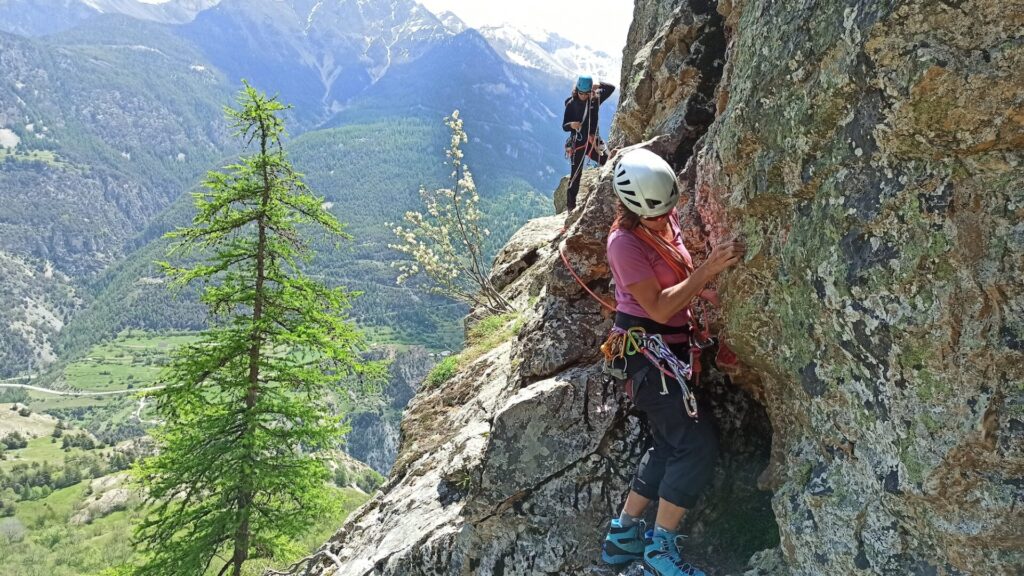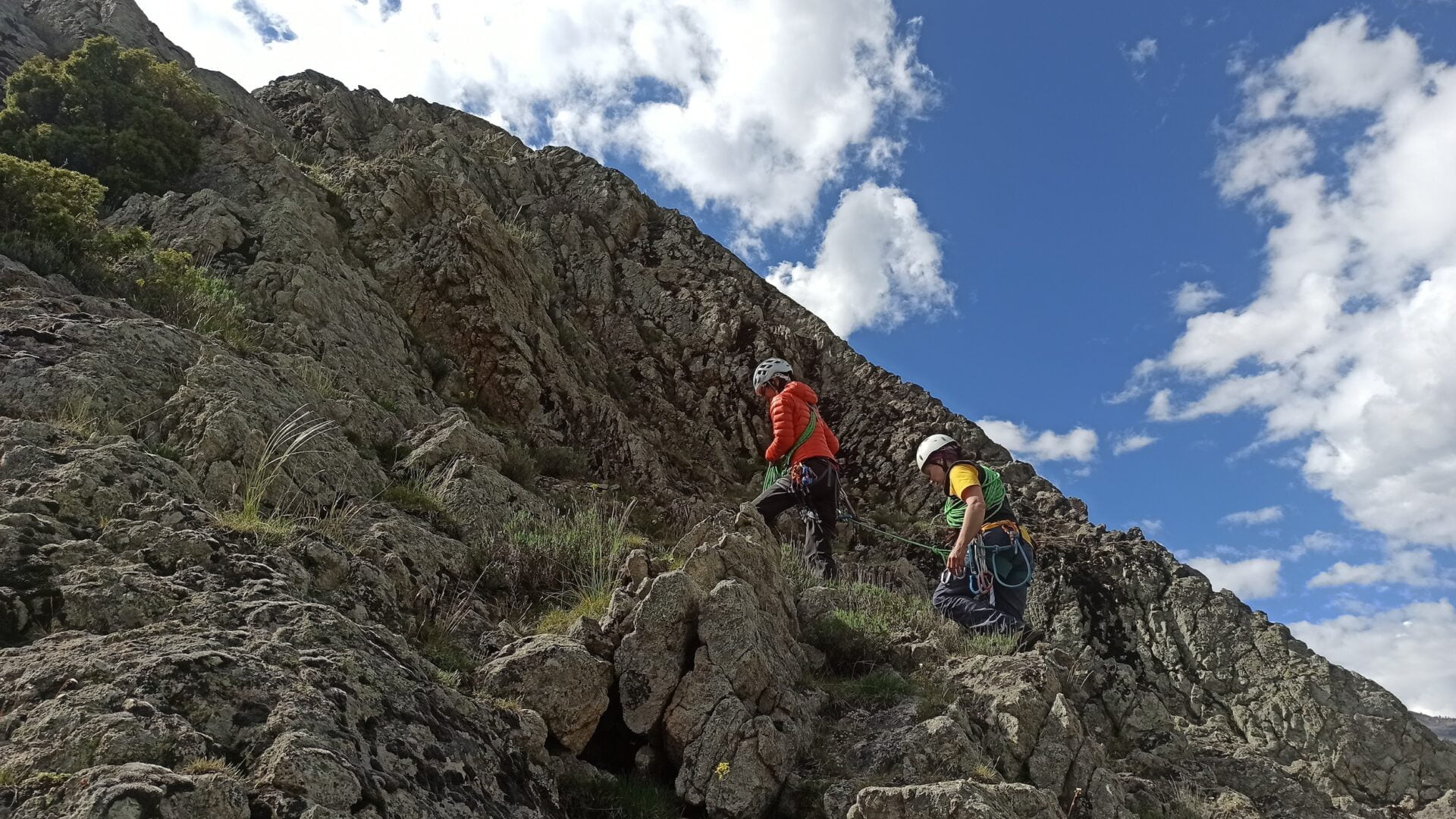Days in the mountains, ridge runs courses and multipitch climbing with Serre Chevalier Sensation, it is possible all year round.
Ridge runs: definition
Mountaineering, as you probably already know, is about climbing mountains… or to take them down. We start with the steep mountain trails, then sometimes come the glaciers and their eternal snow. Sometimes it is also the cliffs that we climb and other times the summit ridges that we climb from one end to the other: the ridge runs.
It is a clever mix between climbing, cradling, abseiling. Like tightrope walkers, we pass on the edge of the edges, sometimes on one side, sometimes on the other. These are generally quite aerial courses but of low difficulty depending on the run chosen.
It is often very fun because we are looking for the easiest route, such as chamois, to make the crossing.

Multipitch climbing
There are several disciplines related to climbing. Generally we know cliff climbing called sport climbing. The lengths are about thirty meters on average. The goal of the game is to reach the top and then go down to perform another sometimes more difficult one according to our desires and motivations.
There is bouldering climbing. This consists of crossing boulders of only a few meters. Without rope but with reception mats that we call crashpads and the presence of our friends on the ground for a possible parade.
This kind of climbing has been a dazzling success in recent years because it can also be practiced indoors on artificial blocks. Requiring very little equipment, this discipline is the joy of young people in search of new sensations. It combines coordination, flexibility, strength and determination.
Climbing on the other hand, consists of climbing a wall of several lengths. From 60 to 500 meters sometimes. The lengths measure between 40 and 50 meters. The first of rope stop at what is called a relay and then by a system of belay raises its second. The operation will be repeated as many times as lengths to be crossed.
Ridge run and multipitch climbing courses
It turns out that following a mountaineering trip last summer on the Blanc glacier and the summit of Roche Faurio, four climbing companions and friends asked me for a more advanced learning to allow them to evolve without a guide.
We therefore agreed to organize a mini course aimed at the general revision of the main rules of the mountain.
Program of the course ridge run and multipitch climbing : Day 1
The multipitch climbing site
The first half day we met on the site of Rocher Baron in Briançon. This site has several large routes of very low difficulty and whose equipment is a bit like those that can be found in large mountain tracks and ridge runs. Pitons, cracks to accommodate mechanical jammers, these famous friends, to add progress points and increase our safety. Relays and natural moorings such as trees, likely to receive straps and therefore, here again, increase our safety during our progress.
In a way: the ideal site for our big revision.
Relays and reminders
We reviewed all the types of relays, on straps, pitons, shafts and wedges that we took the time to learn how to place in the most suitable cracks.
After this long inventory and many exchanges on the choices of each, we reviewed the abseiling.
It was a question of being autonomous to settle on a double rope and to manage its safety to the bottom of the wall.
The different types of belay in multipitch and ridge climbing.
After a short snack break and many exchanges of experiences, we discussed the different types of belays encountered. Classic belay in multipitch then belay in motion and stretched rope during ridge runs. Without a doubt one of the most delicate notions to tackle.
Indeed, these types of belay require both to continue to progress while ensuring maximum safety. It is necessary for this that the first of rope anticipates the terrain, the good path and the points of progression essential to the safety of the rope.
Attacking the multipitch
After developing the ropes, we set off. It is now a question of applying all the techniques reviewed during this intense revision. The technical level being really very easy I can accompany each roped in his choices, his installations, his reflections. Make sure you choose the right progression points to protect yourself and your rope because a fall that is too big could be dangerous. See the solidity of each mooring in place or laid: its friends, pitons, rocky crutches to lay a makeshift relay. Decide the mode of evolution and find the best route to climb to the top.
The summit and the descent
In just a few hours our ropes reach the top. After this first victory, the race is not over, we must now go down. Find the right route and ensure as it should be, even if the terrain is easy, abseiling, de-escalation. In the mountains, 80% of accidents occur on the way down. It is these moments of fatigue after the summit and the crazy desire to finish, to share a beer and to put on the table the last exchanges of a beautiful day.
A race is only over when the car’s engine stops in front of the house.
Day 2 the ridge run

The next day we leave for the Eperon Bouchier. A very easy ridge run above the beautiful little hamlet of Bouchier. The cracks and rocky crutches are numerous, the pitons in place are reminiscent of mountain races. Some passages allow you to climb in stretched rope, others in belay in motion. There are even a few lengths allowing classic climbing. Definitely nature does things well: everything is there and our two ropes can evolve by playing with all the knowledge of the day before.
Run preparation
The idea was to let them prepare the ridge run without taking into account my presence:
– the weather
– the route, topos, accesses
– the choice of equipment
– modes of evolution
This is where the run is played. Good preparation means integrating the next day. To save as much time as possible in these sometimes wild and not always well-marked approaches.
The summit and openness to other notions
Our goal achieved, we take advantage of the magnificent view and the good weather to take out our snacks while still exchanging on this route.
As time allows and we are not in a hurry to go down, I set up new rope manipulations.
During this last chapter, everyone will be able to review, complete, discover , ask forgotten questions, needs to clarify, notions to consider.
We will set up the recall technique in Duffour, then the Marnesouille, then a brief demonstration of a belay in motion during my outings where I am in the most classic configuration: a guide-a client.
Debriefing of these 2 days multipitch and ridge climbing
After these 2 beautiful days, I notice the intensity required of the participants but also of myself.
A great wealth of exchanges, questioning, observation of evolution.
Each has been able to develop a share of experience in a field that was close to her heart.
I’m very positive about this first internship of the summer and I can’t wait to get it back on June 25 and 26 as well.
I thank this great team for their motivation, curiosity and patience. But also for their immense human quality. See you soon.
Benjamin your guide